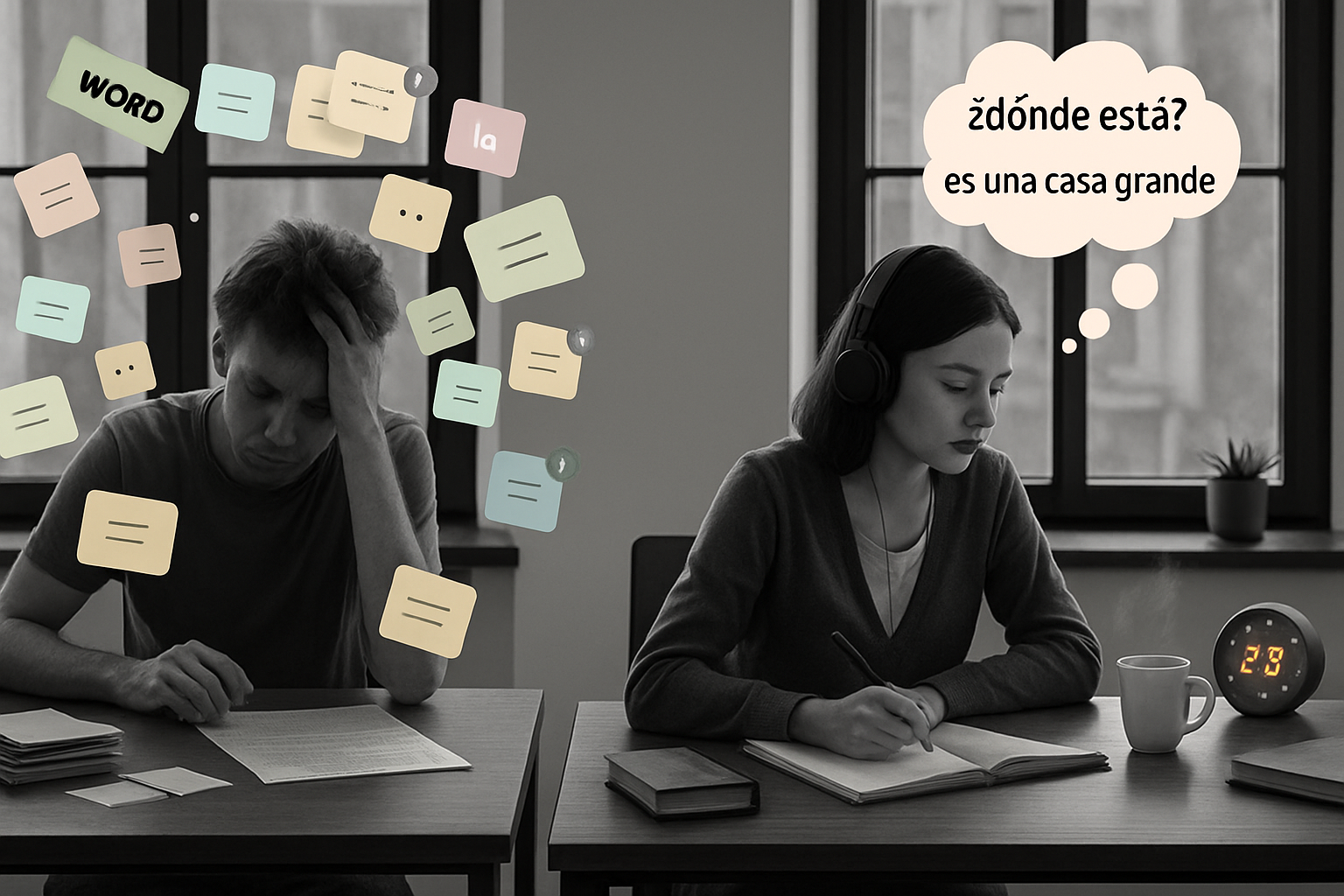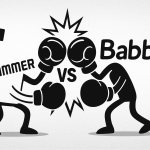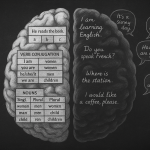When most people think about learning a language using a language learning app, they imagine flashcards, grammar drills, or maybe a streak-counting owl. But what separates dabblers from the truly fluent isn’t how many words they memorized — it’s how well they remember what to say, when to say it, and how to say it again.
This is where repetition systems come in.
Not just any repetition. We’re talking about intelligent, adaptive, full-sentence-spaced-repetition that doesn’t just boost your memory, but trains your brain to think in the language.
In this in-depth comparison, we look at two language learning apps that claim to do repetition well — Taalhammer and Lingvist. Both promise smart algorithms, efficient review, and faster fluency. But only one delivers repetition that actually builds communicative fluency from sentence recall to spoken confidence.
Which one is it? Let’s find out.
- Understanding Spaced Repetition Systems (SRS): What Makes One Better Than the Other?
- Taalhammer’s Spaced Repetition System Explained
- How Lingvist Handles Repetition and Memory
- Taalhammer vs Lingvist: Feature-by-Feature Comparison
- Who Benefits Most from Each App’s Repetition System?
- Which Language Learning App Actually Helps You Remember and Speak?
- Frequently Asked Questions: Which Language Learning App Has the Better Repetition System?
Understanding Spaced Repetition Systems (SRS): What Makes One Better Than the Other?
Spaced Repetition Systems, or SRS, are no longer a buzzword — they’re the backbone of effective language learning. But what separates a truly smart system from a glorified flashcard app? Timing, adaptivity, and integration with real sentence learning.
What Is Spaced Repetition?
At its core, spaced repetition is a memory technique based on reviewing information at increasing intervals. The goal? Beat the “forgetting curve.” But not all systems execute this equally. Some language learning apps simply reschedule reviews after fixed intervals — whether or not you’ve mastered the content. Others, like Taalhammer, use AI to model your personal forgetting patterns and schedule content right before your brain is likely to drop it.
If you’re curious how Taalhammer and Lingvist compare to other apps that use spaced repetition and AI, this breakdown will help.
Fixed vs Adaptive SRS
Lingvist and Taalhammer both claim to use SRS, but their approaches differ.
- Lingvist adapts to your accuracy and speed, adjusting vocabulary frequency accordingly. However, it’s mainly word-based. The system may bring back individual words more or less often depending on your recall success — useful, but still atomized.
- Taalhammer, on the other hand, anchors its SRS in full sentences. The algorithm adapts not only to your memory strength but to grammatical complexity and sentence structure. Missed a phrase in past tense? Expect it to come back — but with new sentence variants that reinforce both meaning and form.
Sentence-Based SRS: A Game Changer?
What makes Taalhammer stand out is that it doesn’t isolate vocabulary from context. Every repetition involves producing or understanding complete, meaningful sentences. This matters because fluency isn’t about knowing 1,000 disconnected words — it’s about stringing them together under pressure.
Studies in cognitive neuroscience support this: active recall (retrieving info from memory) combined with contextual use (grammar in real sentences) forms stronger neural pathways.
Real vs Passive Review
Many apps include “spaced repetition,” but only a few demand active recall. Tapping tiles or re-reading content won’t trigger the same brain engagement as producing a sentence aloud or from scratch. Taalhammer excels here — it nudges you to recall and reconstruct full phrases. Lingvist, while smart on the data side, often limits you to multiple-choice or fill-in-the-blank formats.
In short: not all SRS is created equal. If you want long-term retention and practical fluency, look for systems that personalize deeply, prioritize output, and keep sentences — not just words — at the center of review.
Taalhammer’s Spaced Repetition System Explained
Taalhammer doesn’t just have a spaced repetition system. It is a spaced repetition system — built from the ground up with cognitive science and full-sentence fluency in mind. Unlike a traditional SRS language learning app that focuses on flashcards or fixed intervals, Taalhammer is designed to adapt around your memory decay curve, language level, and learning goals.
This full-sentence-first method sets Taalhammer apart from language learning apps that let you learn in full sentences rather than isolated words.
Sentence-Level Learning and Memory Tracking
At the heart of Taalhammer’s method is full-sentence learning. Every repetition is contextual. You’re not asked to memorize a floating word like “apple.” You’re recalling or producing something like:
“I bought apples yesterday at the market.”
This approach reinforces vocabulary, syntax, grammar, and pronunciation — all in one.
And this matters because the brain forgets in predictable patterns — and what it remembers best are meaningful chunks, not isolated terms.
Taalhammer tracks each learner’s memory strength per sentence. If you struggle with a certain grammatical form or word order, it will reintroduce similar sentences that challenge you just enough to grow — but not enough to frustrate you. The algorithm doesn’t just count how many times you’ve seen a sentence. It tracks how well you remember it — and whether you can use it.
Adaptive AI Review at the Right Time
Taalhammer’s spaced repetition engine is powered by real adaptive AI. Unlike static models that assume everyone forgets on the same timeline, this system recalibrates reviews based on your actual recall behavior. Missed a sentence after three days? The next review will come sooner. Nailed it after a week? Expect a longer interval.
It’s a living algorithm, evolving with you — not just scheduling based on guesswork.
Designed for Output and Long-Term Recall
Most importantly, Taalhammer treats output as non-negotiable. You are constantly prompted to type or say full sentences. This activates deeper memory encoding and builds the reflexes needed for speaking fluently in real situations.
And because the repetition is embedded in meaningful content — not gamified word lists — learners using this language learning app report that they remember phrases longer and use them more confidently.
In short: Taalhammer’s SRS is less about review and more about language mastery — merging science, structure, and real-world speech into every repetition.
How Lingvist Handles Repetition and Memory
Lingvist brands itself as a fast, data-driven way to learn vocabulary using machine learning. It uses spaced repetition, but its implementation — while efficient — has a narrower focus compared to sentence-based systems like Taalhammer.
Word-Frequency Models and Fill-in-the-Blank Exercises
Lingvist is centered around high-frequency vocabulary. It presents users with sentences where a key word is missing, and you’re asked to fill in the blank. This provides some light context, but the emphasis remains on word recall, not on producing or internalizing the sentence itself.
This kind of review improves recognition and speed for individual words, especially for beginners. But it doesn’t scale well to sentence construction or fluency. You remember what goes in the blank — not necessarily how to say the sentence on your own.
Adaptive Learning — But Only at the Word Level
To its credit, Lingvist’s algorithm does adapt. It tracks your success rate and adjusts how often certain words appear based on your performance. This means that harder vocabulary shows up more often, while mastered words fade out over time. It’s efficient and personalized — at the word level.
However, it stops short of tracking sentence patterns, grammar, or syntax. There’s no variation, no sentence transformation, and no progressive grammatical complexity. In short: it’s smart flashcarding — but not structured language growth.
Custom Decks Without Full-Sentence Practice
Lingvist allows users to create custom vocabulary decks, which is great for learners in specific fields (like medical or business Spanish). But again, these are words, not personalized sentences. And since there’s no spoken output, the app doesn’t push you to produce language, only to recognize it.
Efficient, but Not Output-Focused
Lingvist’s SRS is efficient — it’s fast, focused, and can help boost passive understanding quickly. But for learners aiming to speak fluently or build full-sentence reflexes, it may feel limited.
If you’re looking to retain vocabulary and recognize high-frequency words in context, Lingvist delivers. But if your goal is to speak, think, and recall full sentences, its repetition system might not go far enough.
Taalhammer vs Lingvist: Feature-by-Feature Comparison
Now that we’ve unpacked how each app handles repetition, it’s time to line them up side by side. Here’s how Taalhammer and Lingvist compare across key learning dimensions — from memory tracking to speaking output.
Learning Unit: Words vs Sentences
- Taalhammer is sentence-first language learning app. You learn and review usable, real sentences — never isolated words. This aligns with how the brain stores and retrieves language in natural contexts.
- Lingvist is word-first. Words are shown in sentence templates, but the goal is always word recall, not full-sentence construction or production.
Speaking Practice and Output Recall
- Taalhammer emphasizes active recall through speaking and typing. You’re encouraged to say full sentences aloud, mimic native speakers, and build spoken reflexes.
- Lingvist does not include speaking features. It focuses on typing and recognition, making it more passive in terms of output.
Grammar Integration and Sentence Variability
- Taalhammer builds grammar knowledge implicitly through varied sentence structures and targeted repetition. You learn tense, syntax, and prepositions through exposure and correction.
- Lingvist offers exposure to grammar patterns but lacks any form of sentence variation or transformation drills. There’s little structural progression.
Personalization and Learner Control
- Taalhammer lets you add custom sentences, organize content into thematic sets, and tailor repetition to your personal fluency goals. You control what you learn and how you review it.
- Lingvist is a language learning app that allows custom decks for vocabulary but offers limited control beyond word lists. Sentence context is fixed and non-editable.
Memory Tracking and Adaptivity
- Taalhammer uses adaptive AI to monitor your memory strength per sentence, adjusting reviews based on how well you recall structure and meaning.
- Lingvist adjusts based on word-level performance, optimizing for vocabulary retention speed rather than holistic language mastery.
In short: Lingvist is optimized for vocabulary efficiency, while Taalhammer is engineered for sentence-level fluency and output. Next, we’ll explore what type of learner benefits most from each app’s repetition system.
Who Benefits Most from Each App’s Repetition System?
While both apps use spaced repetition to aid memory, they cater to very different types of learners. Understanding who benefits from each system will help you decide which tool aligns with your goals.
Taalhammer: For Learners Who Want to Speak, Not Just Study
Taalhammer is best for learners who aim for spoken fluency, sentence mastery, and long-term language use. It’s especially suited for:
- Adults who want to speak a foreign language in real-world scenarios — not just pass a vocabulary test.
- Learners who prefer full context, structure, and real output over gamified taps and tiles.
- Intermediate learners looking to go beyond flashcards and actually use the language they’re memorizing.
- Anyone focused on long-term retention and fluency automation.
In short, if you’re someone who wants to think in another language — not just recognize words in it — Taalhammer’s repetition system is built for you.
Lingvist: For Learners Who Want Fast Vocabulary Boosts
Lingvist is ideal for learners who want to quickly build up their passive vocabulary, especially:
- Beginners who want to hit the ground running with high-frequency words.
- Students studying for standardized tests or aiming to read and recognize words more easily.
- Casual learners who benefit from short, structured sessions without needing to speak or construct sentences.
It’s a good fit for people who want to understand a language faster, but not necessarily produce it fluently.
If fluency is your goal, you’ll want to compare apps that actually help you become fluent, not just memorize.
Which Language Learning App Actually Helps You Remember and Speak?
If your goal is to recognize words, build vocabulary quickly, and keep study sessions short and structured — Lingvist is a solid option. Its repetition system is fast, adaptive at the word level, and efficient for boosting passive understanding.
But if you want to actually speak, think in the language, and remember full sentences you can use in real life, Taalhammer is the clear winner. Its repetition system goes beyond memory — it builds linguistic reflexes. You don’t just recall; you produce, transform, and speak in full thoughts. That’s the difference between learning a language and living it.
Taalhammer’s sentence-first, output-driven repetition makes it one of the few language learning apps that genuinely helps you become fluent — not just familiar.
Still not sure which language learning app is for you? This guide breaks down why different apps suit different learners and learning goals.
Frequently Asked Questions: Which Language Learning App Has the Better Repetition System?
Does Taalhammer use real AI-based repetition?
Yes. Taalhammer uses adaptive AI to monitor your memory strength at the sentence level. It calculates when you’re statistically most likely to forget a sentence and resurfaces it at just the right time — making the system highly personalized and neurologically efficient.
Can Lingvist help me speak fluently?
Not directly. Lingvist helps you recognize and remember vocabulary through efficient drills. However, it doesn’t include speaking practice, sentence production, or grammar progression — which are critical components for achieving actual fluency.
Which language learning app is better for long-term retention?
Taalhammer. Its sentence-based repetition and active recall approach are better suited for long-term memory consolidation, especially for learners aiming to use the language in real conversations.
What’s the difference between word-level and sentence-level repetition?
Word-level repetition, like Lingvist’s, helps you memorize isolated terms. Sentence-level repetition, like Taalhammer’s, trains you to recall and use complete thoughts — which is essential for fluency. One builds passive knowledge; the other builds active ability.







